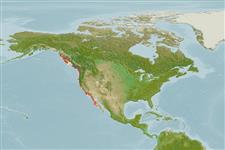Environment: milieu / climate zone / depth range / distribution range
Ecologia
marinhas bentopelágico; intervalo de profundidade 0 - 30 m (Ref. 6885). Temperate; 59°N - 14°N, 136°W - 93°W
Eastern Pacific: Sitka, Alaska to Punta Banda, northern Baja California, Mexico.
Tamanho / Peso / Idade
Maturity: Lm ? range ? - ? cm
Max length : 18.0 cm TL macho/indeterminado; (Ref. 2850); Idade máx. registada: 9 anos (Ref. 56049)
Espinhos dorsais (total): 24 - 27; Raios dorsais moles (total): 9-10; Espinhos anais 1; Raios anais moles: 9. Spinous dorsal represented by a series of small spines, free from membrane; soft dorsal fin triangular and placed well back on body; caudal fin small and finely forked; anal fin spine small and broad, the fin mirroring the soft dorsal fin; pectorals truncate (Ref. 6885). Pale mottled brown, varying from olive green to yellow brown dorsally; creamy white ventrally; a bright silvery patch between operculum and pectorals extending to throat and bounded above by a dark band that extends forward through eye to snout; breeding males with bright red snout and phosphorescent snout (Ref. 6885).
Found in kelp beds, eelgrass, rocky areas, and over sand bottoms (Ref. 2850). Usually near the surface in schools, sometimes in dense schools well offshore (Ref. 2850). Feeds on small crustaceans and fish larvae (Ref. 6885). Minimum depth reported taken from Ref. 57178.
Nest is built, usually in kelp. Males are territorial (Ref. 6885) and guard the nest.
Eschmeyer, W.N., E.S. Herald and H. Hammann, 1983. A field guide to Pacific coast fishes of North America. Boston (MA, USA): Houghton Mifflin Company. xii+336 p. (Ref. 2850)
Categoria na Lista Vermelha da IUCN (Ref. 130435)
Ameaça para o homem
Harmless
Utilização humana
Aquário: Aquários públicos
Mais informação
ReferênciasAquaculturaPerfil para aquaculturaEstirpesGenéticaElectrophoresesHereditariedadeDoençasProcessamentoNutrientsMass conversion
ColaboradoresFotografiasStamps, Coins Misc.SonsCiguateraVelocidadeTipo de nataçãoÁrea branquialOutras referênciasCérebrosVisão
Ferramentas
Relatórios especiais
Descarregue XML
Fontes da internet
Estimates based on models
Preferred temperature (Ref.
123201): 8.9 - 17.3, mean 10.4 °C (based on 184 cells).
Phylogenetic diversity index (Ref.
82804): PD
50 = 1.5000 [Uniqueness, from 0.5 = low to 2.0 = high].
Bayesian length-weight: a=0.00263 (0.00103 - 0.00672), b=3.14 (2.92 - 3.36), in cm total length, based on LWR estimates for this (Sub)family-body shape (Ref.
93245).
Nível Trófico (Ref.
69278): 3.4 ±0.42 se; based on food items.
Generation time: 2.1 ( na - na) years. Estimated as median ln(3)/K based on 1
growth studies.
Resiliência (Ref.
120179): Médio, tempo mínimo de duplicação da população 1,4 - 4,4 anos (tm=1; tmax=9; Fec=1,200; K=0.5).
Fishing Vulnerability (Ref.
59153): Low vulnerability (25 of 100).
Nutrients (Ref.
124155): Calcium = 59.4 [36.7, 125.3] mg/100g; Iron = 0.409 [0.237, 0.732] mg/100g; Protein = 16.6 [15.4, 17.8] %; Omega3 = 0.449 [0.219, 0.928] g/100g; Selenium = 10.7 [4.5, 23.6] μg/100g; VitaminA = 46.3 [11.9, 175.5] μg/100g; Zinc = 0.781 [0.547, 1.090] mg/100g (wet weight);
